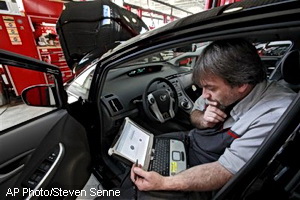 Driver’s Account Doesn’t Match With Findings
Driver’s Account Doesn’t Match With Findings
For the past week, the media have been waiting for the results of an investigation into Jim Sikes’ runaway Toyota Prius. While the investigation was taking place, a Congressional memo leaked, followed by an NHTSA report, both of which found little evidence to support Sikes’ story. Now, Toyota has released its preliminary report on the incident, and the automaker has reached the same conclusion.
Toyota engineers completed an investigation of the 2008 Prius driven by Mr. James Sikes that was the subject of a 911 emergency call on Monday, March 8. 61 year-old Mr. Sikes reported that the vehicle was traveling at a high rate of speed down a San Diego freeway, the accelerator pedal was stuck, and that the vehicle was out of control and could not be stopped. The emergency operator repeatedly instructed the driver to shift the car into neutral and turn off the power button.
Sikes refused to heed the operator’s advice to turn off the car or put the transmission in neutral, concerned that the car would flip over if he did. After a half-hour run down the freeway, a California Highway Patrol officer who had caught up with Sikes advised him to use both the brake pedal and parking brake to stop the car. After bringing the speed down from 94 mph to about 50 mph, Sikes finally turned the car off.
While a final report is not yet complete, there are strong indications that the driver’s account of the event is inconsistent with the findings of the preliminary analysis. Toyota has released the preliminary findings from its own report with help from the NHTSA and, unsurprisingly, has come to the same conclusions. After inspecting the car, downloading data from the onboard computer, testing the car and even retracing Sikes’ route, Toyota was unable to find any defect with the car.
The automaker said Monday that it found Sikes rapidly pressed the gas and brakes back and forth 250 times, the maximum amount of data that the car’s self-diagnostic system can collect. That account appears to contradict Sikes’ statements — backed by the California Highway Patrol — that he slammed the brakes, even lifting his buttocks off the seat.
Listed below are the key facts Toyota uncovered:
- The accelerator pedal was tested and found to be working normally with no mechanical binding or friction. It should be noted that the Prius is not subject to a recall for sticking accelerator pedals and the Prius component is made by a different supplier than the one recalled.
- The front brakes showed severe wear and damage from overheating. The rear brakes and parking brake were in good condition and functional.
- A Toyota carpeted floor mat of the correct type for the vehicle was installed but not secured to the retention hooks. It was not found to be interfering or even touching the accelerator pedal.
- The pushbutton power switch worked normally and shut the vehicle off when depressed for 3 seconds as the 911 operator advised Mr. Sikes to do.
- The shift lever also worked normally and neutral could be selected. The neutral position is clearly marked and can be easily engaged by moving the lever left to the “N” marking.
- There were no diagnostic trouble codes found in the power management computer, nor was the dashboard malfunction indicator light activated. The hybrid self-diagnostic system did show evidence of numerous, rapidly repeated on-and- off applications of both the accelerator and the brake pedals.
- After examination of individual components, the front brakes were replaced and the vehicle was test driven, during which the vehicle was observed to be functioning normally.
- During testing, the brakes were purposely abused by continuous light application in order to overheat them. The vehicle could be safely stopped by means of the brake pedal, even when overheated.
The Prius braking system uses both conventional hydraulic friction brakes and a regenerative braking system which switches the electric drive motors into brakes to generate electricity.
The system features a sophisticated self- protection function which cuts engine power if moderate brake pedal pressure is applied and the accelerator pedal is depressed more than approximately 50 percent, in effect providing a form of “brake override.”
This function, which is intended to protect the system from overload and possible damage, was found to be functioning normally during the preliminary field examination.
Toyota engineers believe that it would be extremely difficult for the Prius to be driven at a continuous high speed with more than light brake-pedal pressure, and that the assertion that the vehicle could not be stopped with the brakes is fundamentally inconsistent with basic vehicle design and the investigation observations.
Last week the media discovered that Sikes had a history of financial trouble and may have been behind on his car payments, but Sikes assured people he wasn’t looking for a handout or a lawsuit. Later in the week, reports from Congress as well as the NHTSA would indicate that no one had yet been able to discover a problem with Mr. Sikes’ car or duplicate his situation.
The 2008 Prius is not part of the brake recall.
The following page is video of Sikes’ runaway Prius on the San Diego freeway and a copy of the press release from Toyota


Leave a Reply